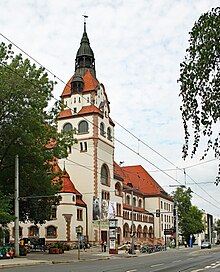Young World Theater

The Young World Theater (abbreviated TdJW) in Leipzig is the oldest professional children's and youth theater in Germany. With its cross-age and cross-disciplinary program, it offers pieces for children, young people and families in Leipzig.
history
The theater of the Junge Welt was opened after the Second World War, modeled on Soviet youth work, as the first theater of its kind in the German-speaking area. The Moscow children's and youth theater formed by Natalia Saz in 1918 was regarded as an artistic model . Who was Venue White Hall in the Congress Hall at the Zoo . On November 7, 1946, the first play, Erich Kästner's Emil and the Detectives, was performed. This day was assumed to be the date the theater was founded in the absence of more precise dates.
At the beginning of the 1950/51 season, the youth theater was integrated as a division - alongside opera , drama and operetta ( musical comedy ) - in the Leipzig City Theater . In the course of the change in the GDR, this “theater combine” was dissolved on January 1, 1990. Since then, the Young World Theater has been a separate company owned by the City of Leipzig. His manager Hanns Gallert rose from divisional director to artistic director.
In 1989 arson made the White Hall unusable. The ensemble then played in different locations, including in Haus Leipzig , until 2003 in the former Haus der Volkskunst in Lindenau , which has now been converted into the Leipzig Theater House and has become a permanent home.
Venues
The Young World Theater has three different permanent venues: the Great Hall with a maximum capacity of 229 seats, the Small Hall with 90 and Floor One with 50 seats. In addition, pieces are played in the theater bus, in kindergarten or in the classroom.
Directly in the theater there is also the theater-bar PAN, which also hosts evening events.
Awards
The Theater der Junge Welt was awarded the Federal Theater Prize in 2015 and the Saxon Theatertreffen Prize in 2016 for its production of "Crystal - Variations on Rush" . In 2016, the production “Brennpunkt: X” also received the Saxon Prize for Democracy .
ladder
The following people headed the theater artistically. In the GDR , the theater of the Junge Welt was only a division of the Leipzig City Theater from 1950 to 1989 and therefore had no artistic director of its own, but only one director . Since 1990 the TdJW has been a separate institution with its own director .
- 1946–1949: Richard Füchsler (administration: Erna Ueberrück)
- 1950–1954: Josef Stauder
- 1954–1957: Herta Greef
- 1957–1959: Rudi Kurz
- 1959–1977: Hans-Dieter Schmidt
- 1977–1987: Günter Schwarzlose
- 1987-2000: Hanns Gallert
- 2000 – March 2001: Tilo Esche
- March 2001–2002: Marion Firlus (Interim)
- since 2002: Jürgen Zielinski
literature
- Theater of the Young World (Ed.): 70 years of the future. Theater der Zeit, Berlin 2016, ISBN 978-3-95749-075-9 .
- Theater of the Young World (Ed.), Ullrich Kroemer: The game with others. Football between integration and discrimination . Verlag Die Werkstatt, Göttingen 2017, ISBN 978-3-7307-0357-1 .
Web links
Individual evidence
- ^ Website Theater der Junge Welt
- ↑ a b "... we are awake!" Leipzigs Neue, November 17, 2006
- ↑ MDR background conversation ( page no longer available , search in web archives ) Info: The link was automatically marked as defective. Please check the link according to the instructions and then remove this notice.
- ↑ Thomas Höpel: "The Art of the People". Urban cultural policy in Leipzig and Lyon 1945–1989. Leipziger Universitätsverlag, 2011, p. 159.
- ^ Manfred Pauli: A theater empire on the Pleiße. Studies on Leipzig theaters in GDR times. Schkeuditzer Buchverlag, 2004, p. 193.
Coordinates: 51 ° 20 ′ 16 ″ N , 12 ° 20 ′ 0 ″ E
